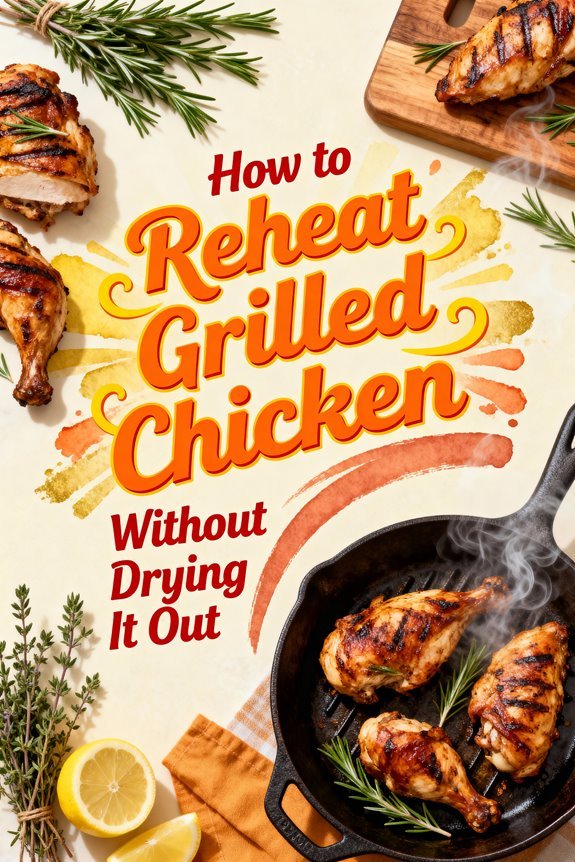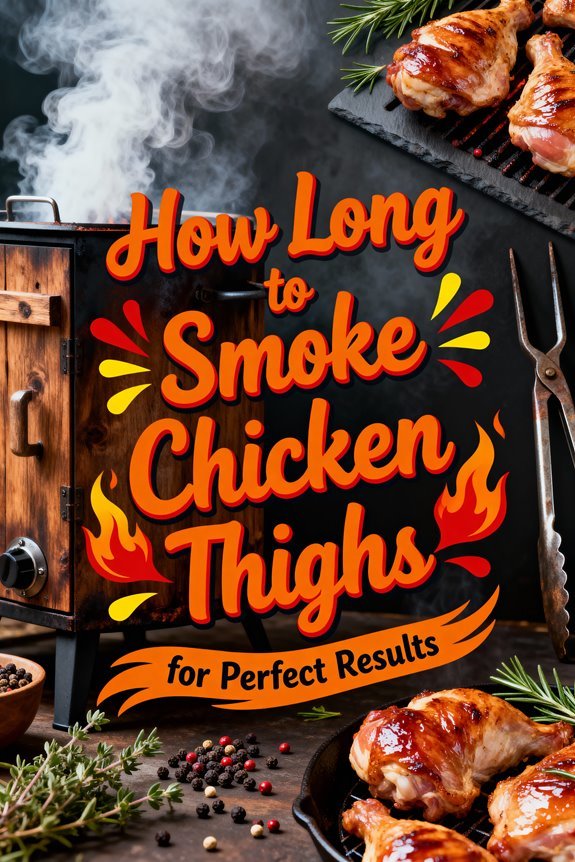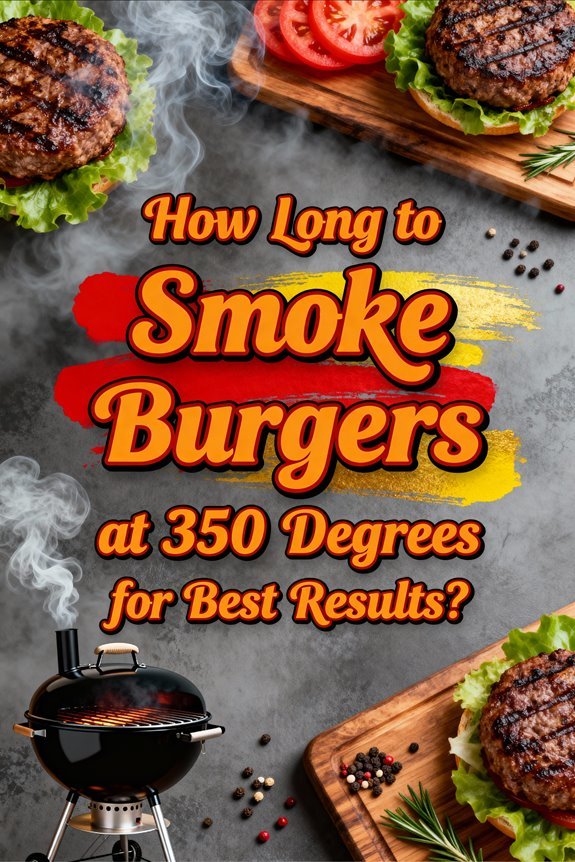To reheat grilled chicken without drying it out, you’ll want to use gentle heat and add moisture. The oven method works best: wrap your chicken in foil with a tablespoon of chicken broth, then heat at 300°F for 15-20 minutes until it reaches 165°F internally. Alternatively, use an air fryer at 360°F for 5-7 minutes, lightly brushing the chicken with oil first. Always let it rest for 3-5 minutes after reheating to redistribute the juices. Below, we’ll explore the specific techniques that guarantee restaurant-quality results every time.
Best Methods for Reheating Grilled Chicken While Maintaining Moisture
When reheating grilled chicken, selecting the right method directly impacts moisture retention and texture quality. The air fryer excels at preserving juiciness—preheat to 360°F, arrange pieces in a single layer, and heat for 5-7 minutes, flipping halfway through. For stove-top reheating, use a covered skillet with chicken broth over medium heat for approximately 6 minutes. The oven method works best for larger portions: wrap chicken in foil at 300°F for 15-20 minutes. Regardless of your chosen technique, always verify the internal temperature reaches 165°F using a thermometer. Add liquids like broth or water to create steam, which prevents drying. Avoid cutting chicken into smaller pieces before reheating, as this increases moisture loss through exposed surface area. Lightly coating the chicken with olive oil or cooking spray helps retain moisture and enhances the exterior texture during reheating. For best quality and safety, only reheat previously frozen chicken that has been properly thawed in the refrigerator. Properly stored leftovers remain safe to eat for three to four days when refrigerated at or below 40°F.
Essential Tools and Ingredients You’ll Need
Successfully reheating grilled chicken requires specific equipment and ingredients to execute the methods outlined above. Vital tools include an accurate meat thermometer to verify the internal temperature reaches 165°F, preventing foodborne illness. You’ll need an air fryer for ideal crispiness, a heavy-bottomed skillet for stovetop methods, or a conventional oven for larger portions. Aluminum foil retains moisture during oven reheating, while tongs prevent meat damage when handling. Microwave-safe dishes are necessary if using the microwave for boneless, skinless chicken pieces.
Key ingredients encompass cooking spray or neutral oil to prevent sticking and promote browning. Chicken broth adds essential moisture, especially for bone-in pieces. Optional seasonings like kosher salt, black pepper, and dried herbs restore flavor lost during storage. Heat-resistant gloves protect against burns, while airtight containers guarantee proper storage post-reheating. Similar to bratwurst, allowing your reheated chicken to rest for 5-10 minutes helps seal in the juices. Setting your oven to low temperatures between 250-350°F ensures gentle, even reheating without excessive moisture loss.
Step-by-Step Guide for Each Reheating Method
Four proven methods exist for reheating grilled chicken, each delivering distinct textural outcomes and requiring specific techniques to prevent moisture loss. While even thickness is crucial for initial cooking, proper reheating techniques are equally important for maintaining quality. Similar to how internal temperature ensures properly cooked burgers, monitoring heat is essential for reheated chicken.
The air fryer excels at 360°F for 5-7 minutes, using cooking spray and mid-point rotation to achieve 165°F internal temperature while preserving moisture. The oven method employs loose foil wrapping at 320°F for 15-20 minutes, with wire racks ensuring even heat distribution. Stovetop tips include adding water to your skillet, maintaining medium heat, and covering for approximately 6 minutes until proper temperature registers. The microwave requires 1-2 minute intervals with damp paper towel coverage, checking every 30 seconds. The choice of reheating method ultimately depends on personal preference and the type of chicken being reheated.
Regardless of method, monitor internal temperature religiously, add liquid for steam generation, and avoid prolonged exposure to heat sources for ideal results.
Temperature and Timing Guidelines for Perfect Results
Precision in temperature control separates perfectly reheated grilled chicken from dry, overcooked protein. Set your oven between 325°F to 350°F—boneless breasts need 15–20 minutes at 325°F, while bone-in cuts require 25 minutes at 350°F. Cover with foil and add broth to the baking dish, mimicking the moisture retention from effective chicken marinades. For air fryers, preheat to 360°F and reheat for 5–7 minutes, lightly coating with oil to restore the crispiness achieved through proper grilling techniques. Always verify an internal temperature of 165°F using a food thermometer, holding for 15 seconds. Rest your chicken 3–5 minutes post-reheating to redistribute juices. Similar to low-temperature smoking techniques at 225°F, slow and steady reheating yields the juiciest results. Adjust timing based on thickness—thinner pieces reheat faster, preventing the toughness that undermines your original grilling efforts. Avoid increasing oven temperature to rush the process, as this shortcut leads to dried-out meat that loses the succulence you worked to achieve. Consider direct heat grilling at 425-450°F when preparing fresh chicken breasts for the best initial results and easier reheating later.
Pro Tips to Keep Your Chicken Juicy and Flavorful
Mastering temperature and timing means little if your chicken emerges dry and flavorless from the reheating process. Moisture retention begins with adding liquid—place chicken in a baking dish with one cup of broth to generate steam. Wrap tightly with aluminum foil to trap moisture, or use a covered skillet on the stovetop. Lightly brush chicken with oil before reheating to seal in juices and prevent surface drying. Similar to grilling burgers at medium-high heat, maintain a moderate temperature around 350°F for even reheating. Consider serving with baked beans for a protein-rich, flavorful meal that complements the reheated chicken perfectly.
For flavor enhancement, layer chicken with barbecue sauce, gravy, or marinade before heating. Add aromatics like garlic, herbs, or lemon slices underneath for infusion without moisture loss. Reheat larger pieces rather than small slices—reduced surface area minimizes evaporation. Monitor closely to avoid overcooking, and use a basting bulb to keep surfaces moist throughout the process. Always reheat chicken only once after storage to limit bacterial growth and maintain optimal texture.
How to Restore Crispiness to Your Reheated Grilled Chicken
While reheating grilled chicken thoroughly matters for food safety, restoring its original crispy exterior requires different techniques than simple warming. Crispy restoration depends on controlled heat and proper air circulation. Air fryer techniques excel here—preheat to 360°F, lightly coat chicken with oil, and arrange pieces in a single layer. Reheat for 5-6 minutes, flip, then continue for 2-5 minutes until reaching 165°F internally.
For oven methods, use a wire rack over your baking sheet at 400°F for tenders or 350°F for bone-in pieces. This elevation allows hot air to crisp all surfaces evenly. Similar to low and slow smoking methods used for brisket, maintaining consistent temperature is crucial for even reheating results. Just as medium-high heat produces the juiciest burgers, monitoring temperature prevents overcooking your reheated chicken. Flip halfway through, then finish under the broiler briefly to restore that coveted golden-brown exterior. The toaster oven works similarly at 400°F—7 minutes, flip, then 3 additional minutes for perfectly crisped small portions. Before reheating, remember to scrape off any sauces to prevent the chicken from becoming soggy during the warming process.







